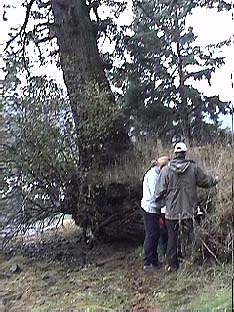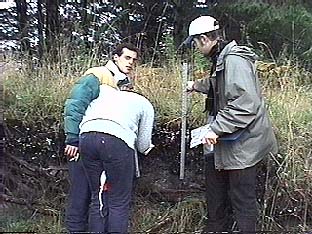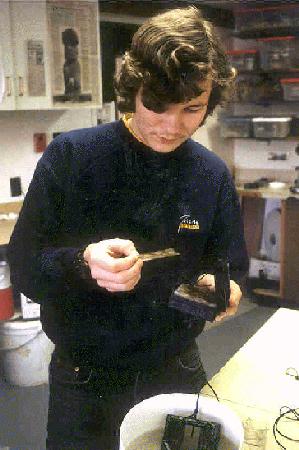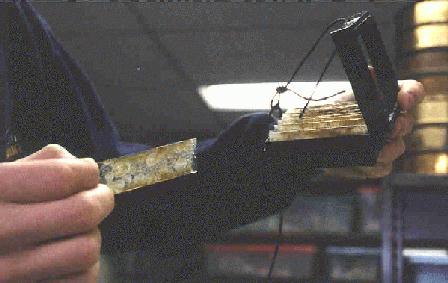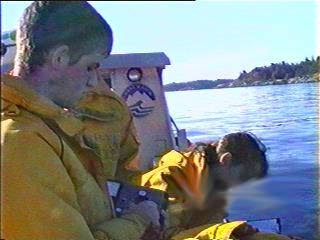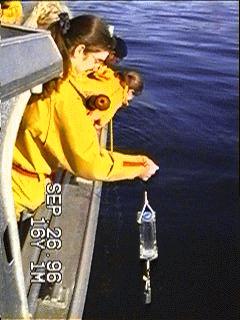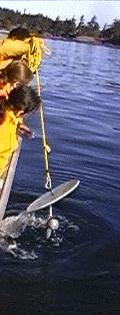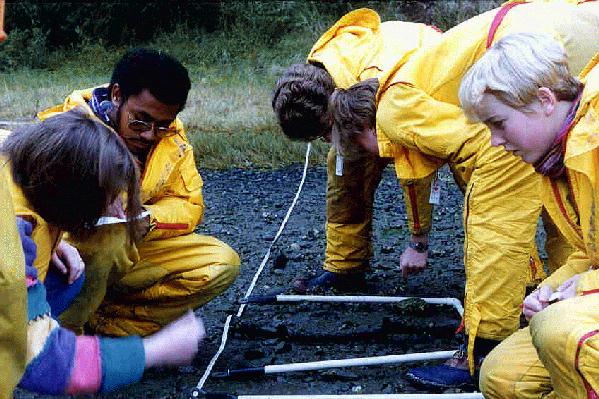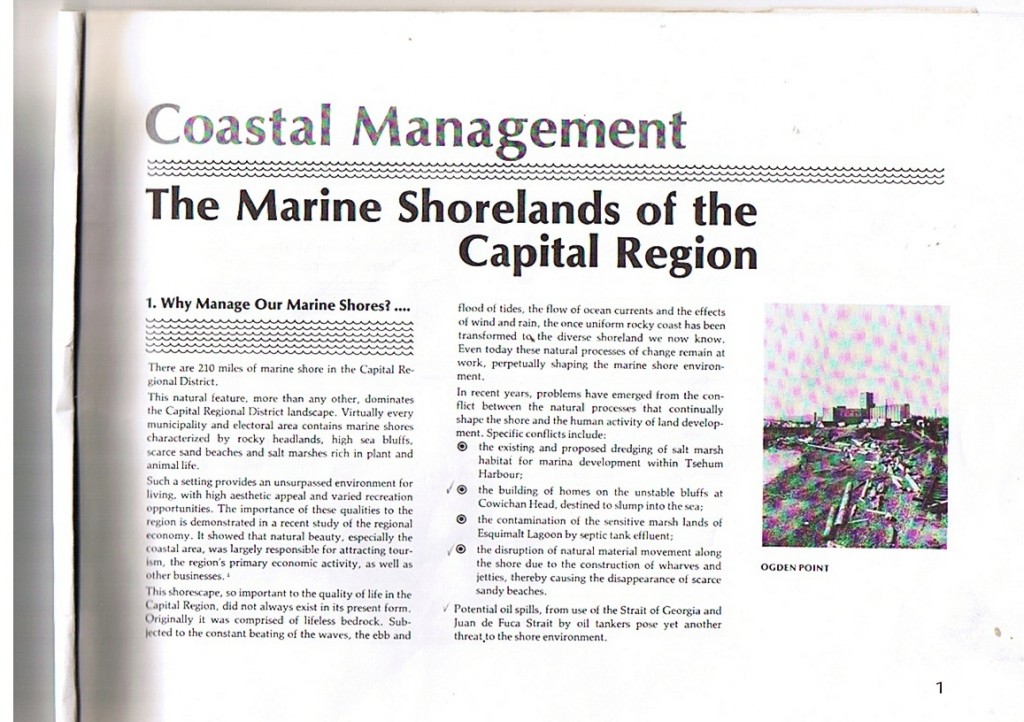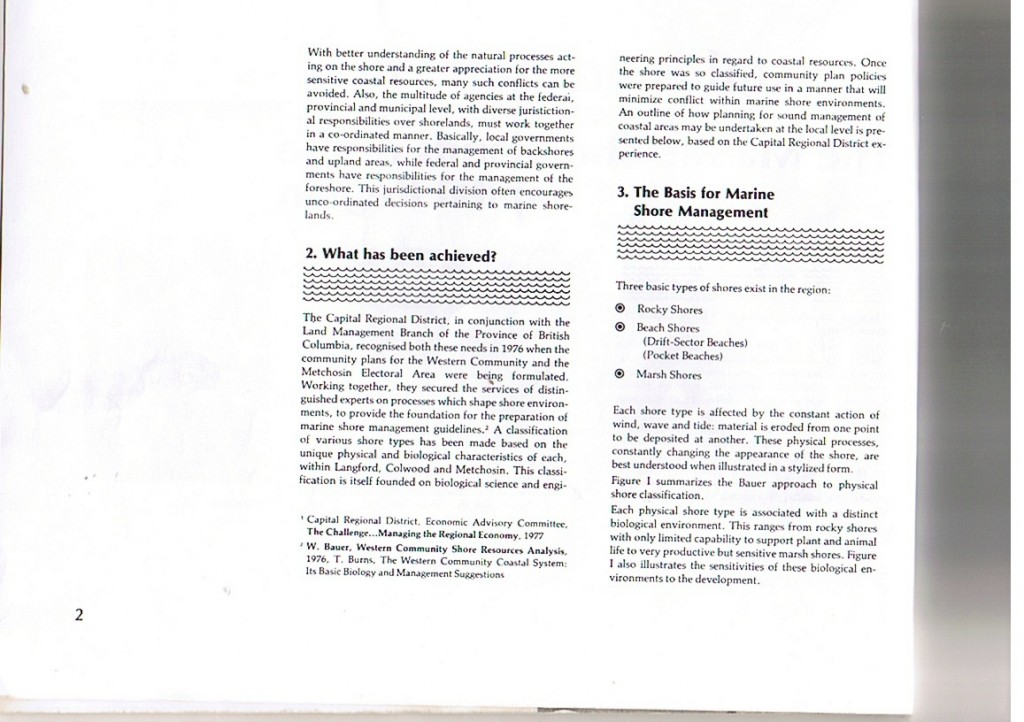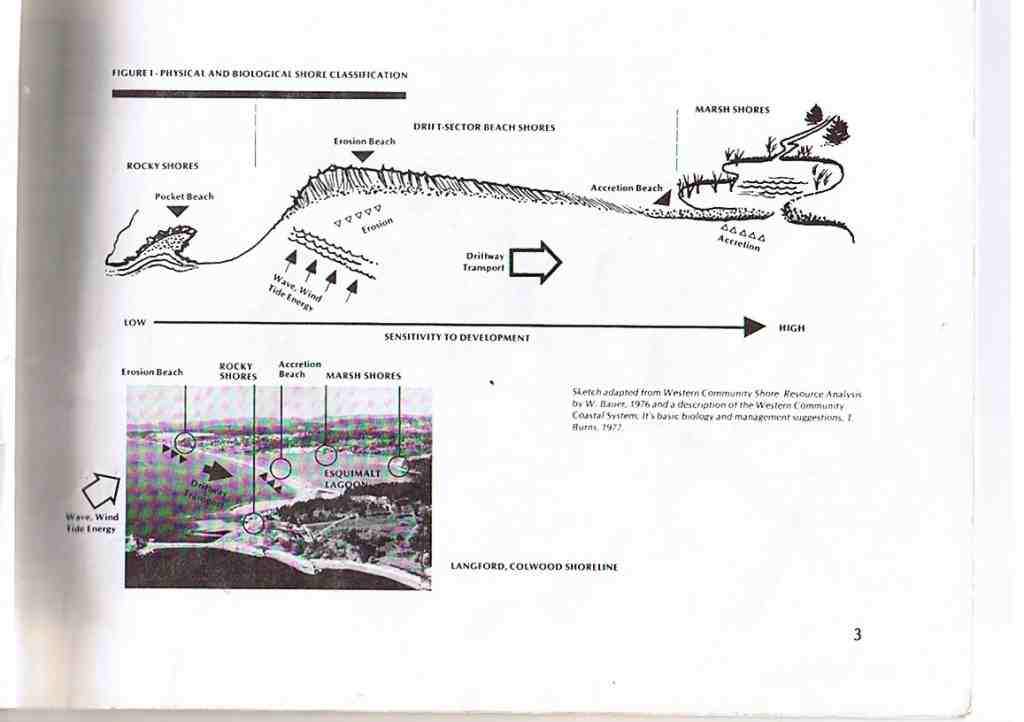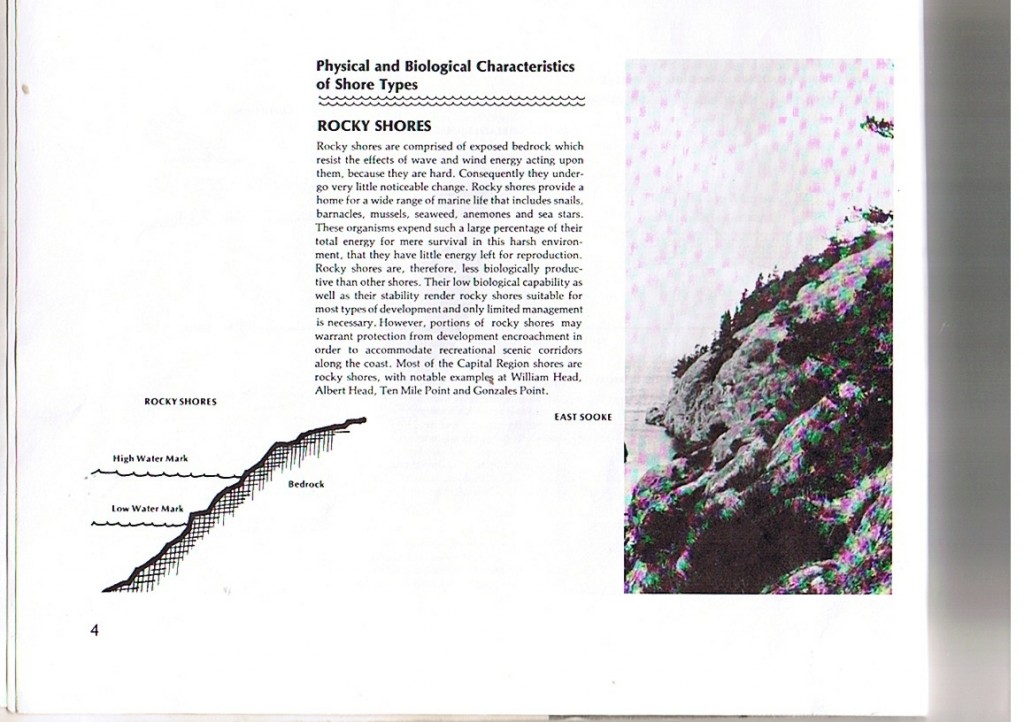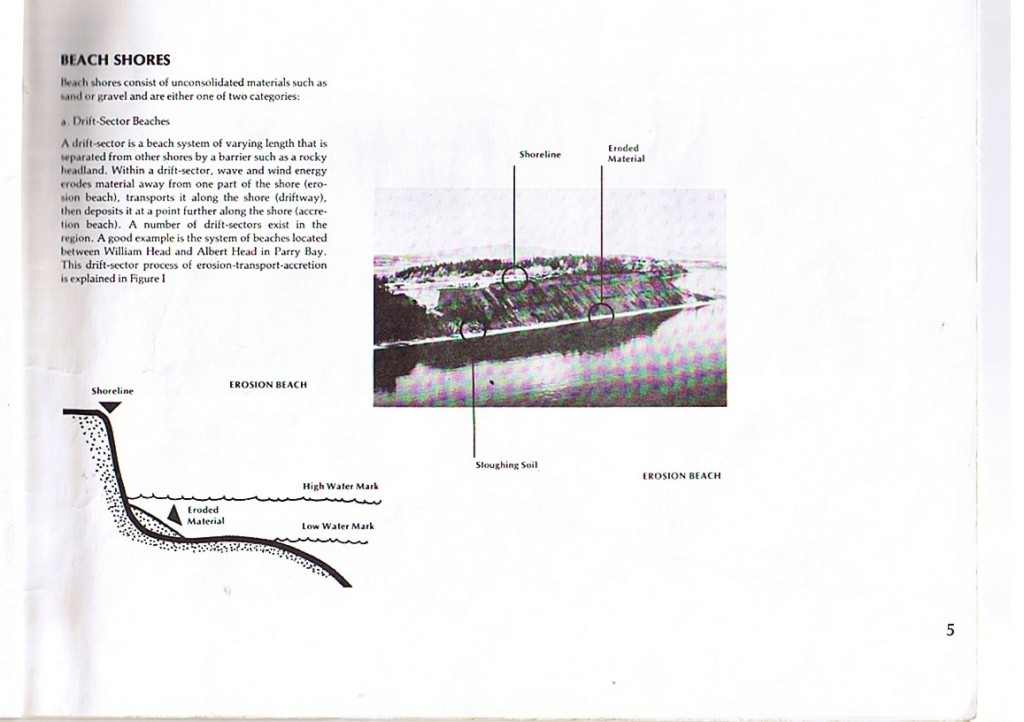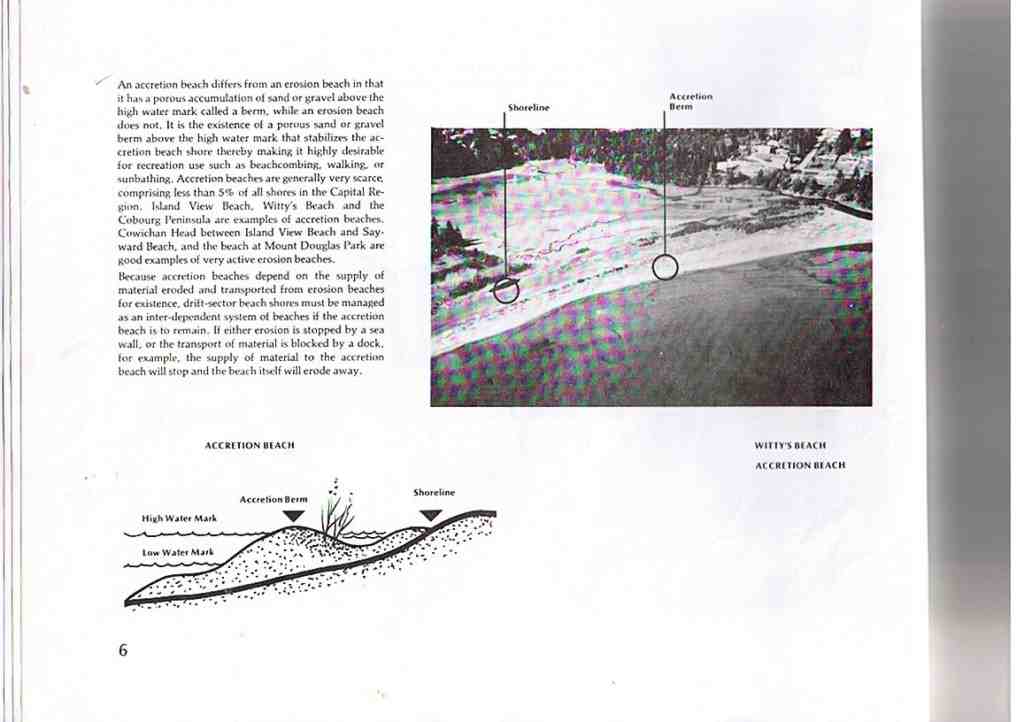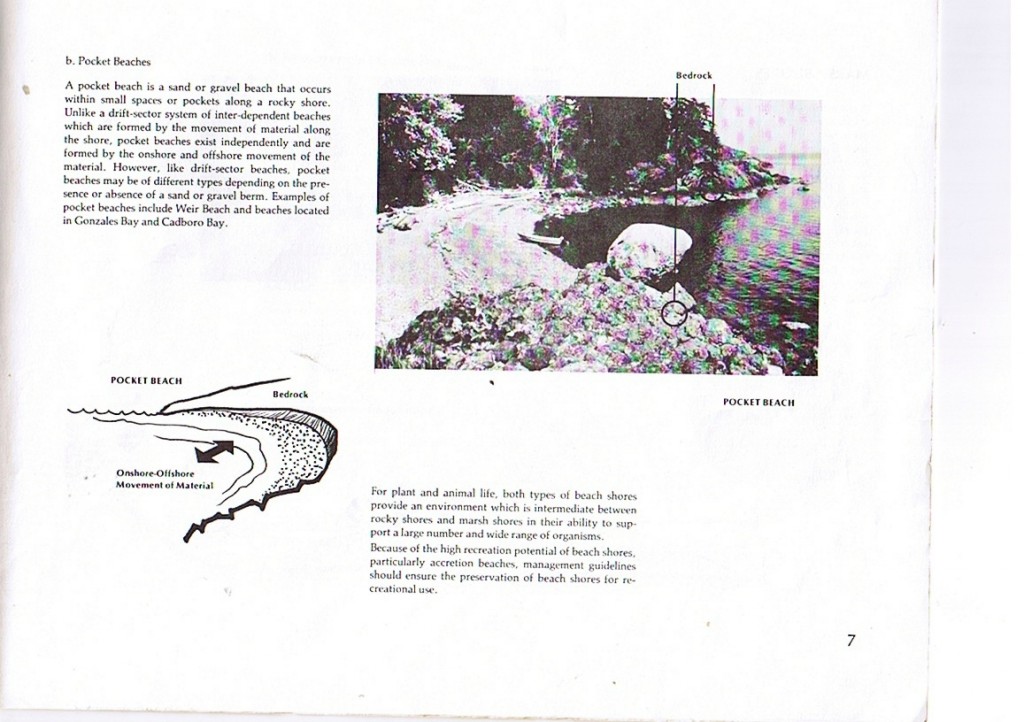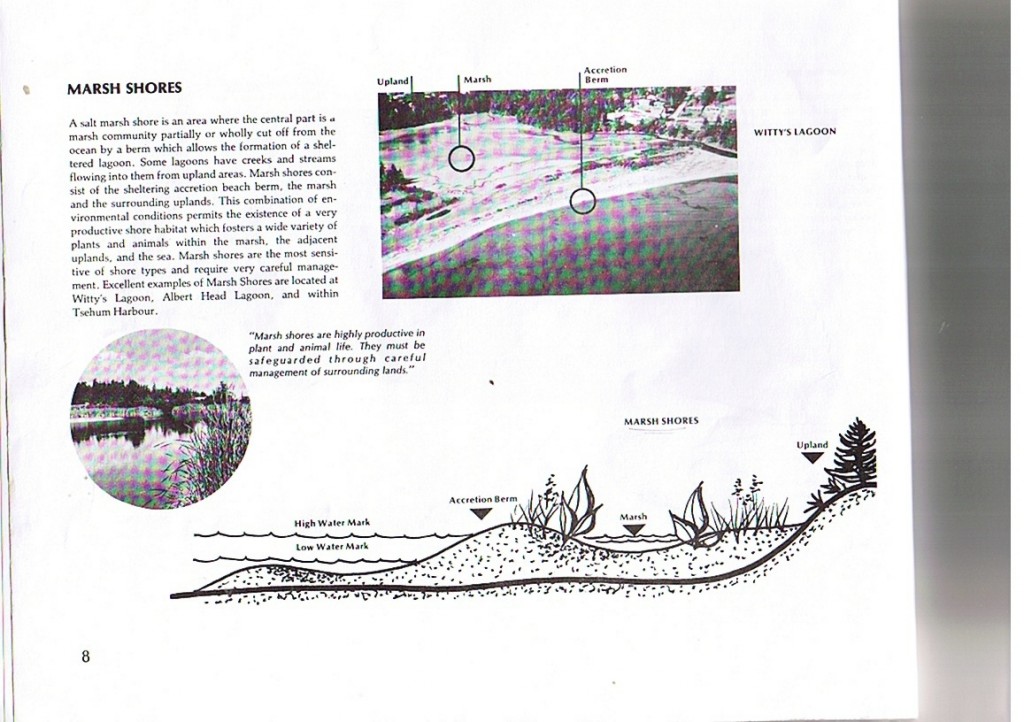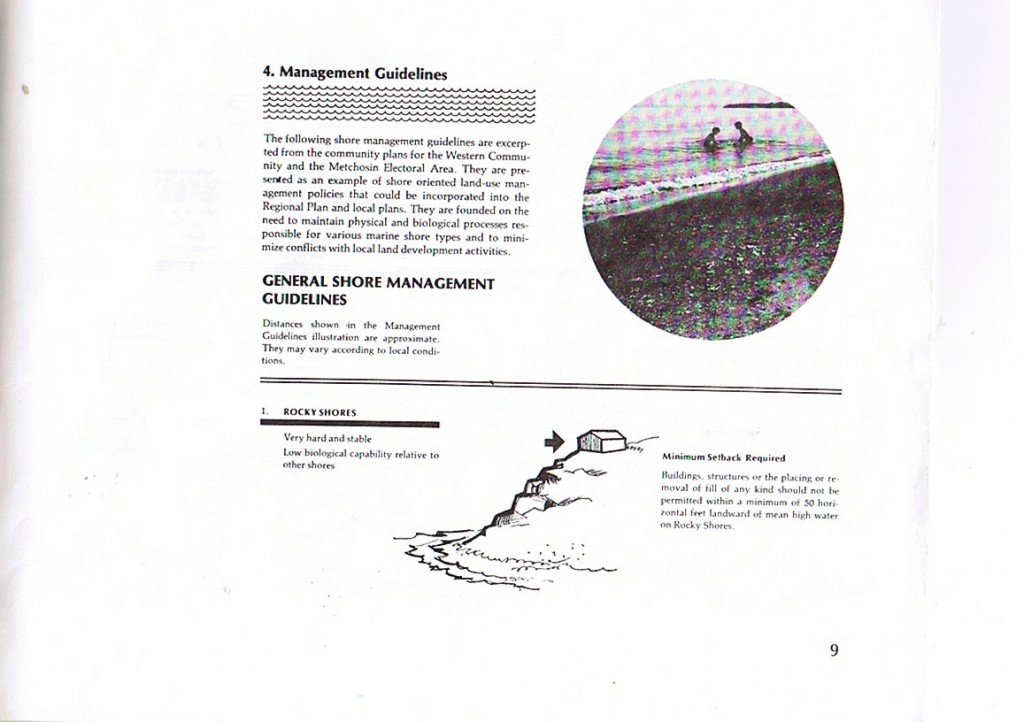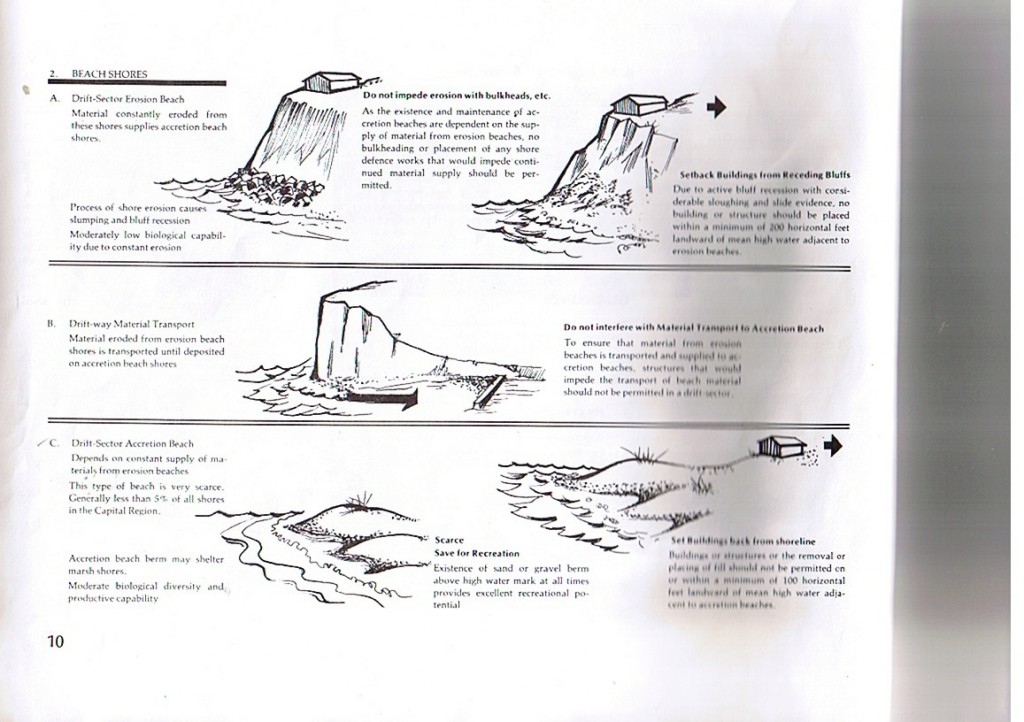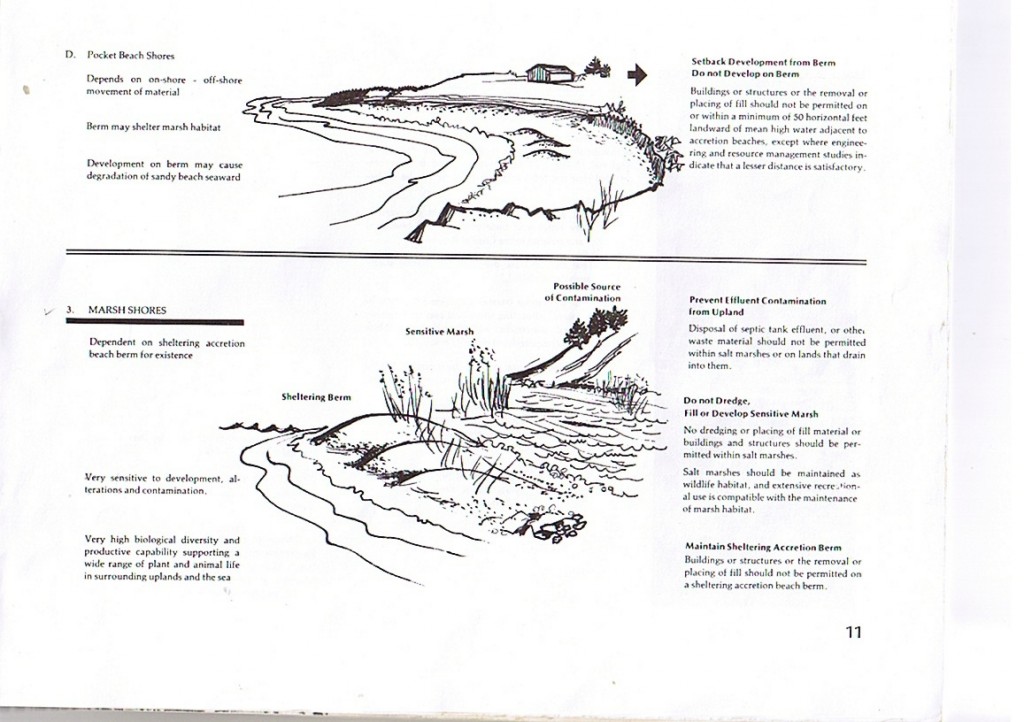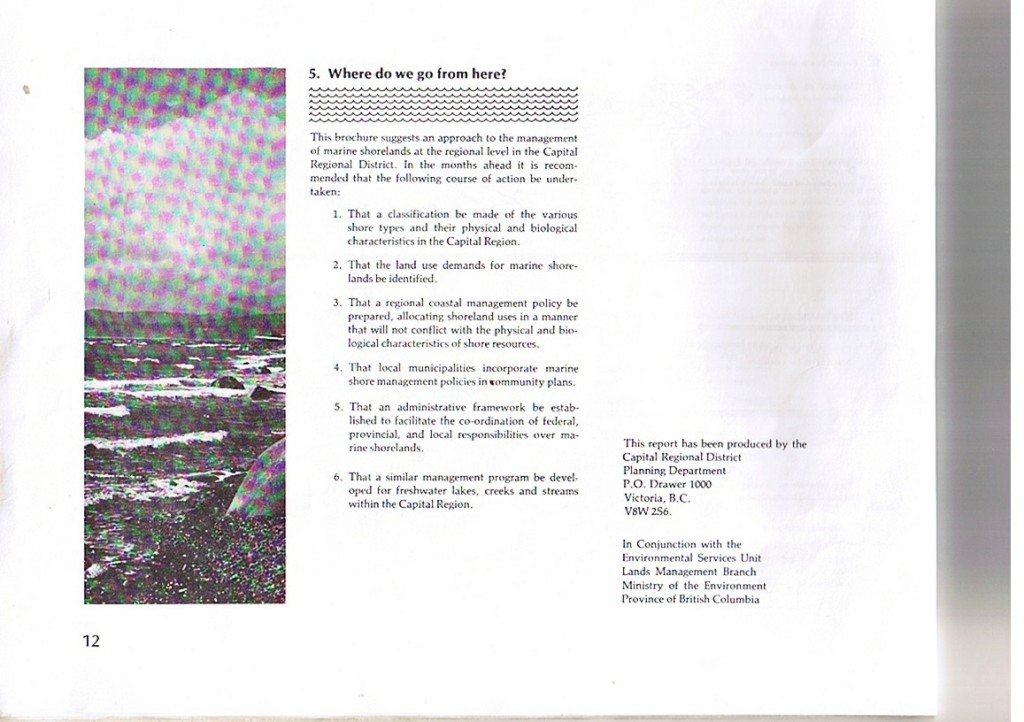SPECIES LIST:
Compiled by:Donna Gibbs of the Vancouver Acquarium on dives made at Rosedale Rock, West Race Rocks and William Head in the summer of 1997. Groupings are made in Phylums or Divisions.
Dive 432 – Rosedale, Race Rocks – June 12, 1997
|
Epiphytic red algae (Smithora, Antithamnion, Ceramium, Polysiphonia) Iridescent blade red algae (Iridea) Encrusting coralline algae (Lithothamnion) Branching coralline algae (Bossiella, Corallina, Calliarthron) |
Bull kelp (Nereocystis)
Blade kelp (Costaria) Blade kelp (Alaria) Woody-stemmed kelp (Lessoniopsis, Eisenia, Pterygophora) |
Tar spot (Codium setchellii) |
| Tan finger sponge (Isodictya quatsinoensis)
Orange-red encrusting sponge (Ophlitaspongia pennata) Thick, dark red encrusting sponge (Plocamia karykina) Boring sponge (Cliona celata) Crumb-of-bread sponge (Halichondria, Haliclona spp.) |
Giant black feather-duster worm (Eudistylia vancouveri)
Sand-dwelling feather-duster worm (Sabella spp.) Slime tubeworm (Myxicola infundibulum) Multi-colour calcareous tubeworm (Serpula vermicularis) Honeycomb tubeworm (Dodecaceria fewkesi) Spaghetti or shell binder worm (Thelepus crispus) |
Plumose anemone (Metridium giganteum)
Red and green or Christmas tealia (Urticina crassicornis) Crimson anemone (Cribrinopsis fernaldi) Brooding or proliferating anemone (Epiactis prolifera) Zoanthid (Epizoanthus scotinus) Ostrich-plume hydroid (Aglaophenia struthionides) Delicate-plumed hydroid (Plumularia spp.) Orange hydroid (Garveia annulata) Snail-fur hydroid (Hydractinia sp.) Pink-mouthed solitary hydroid (Tubularia marina) Thread-like, creeping network hydroid (Orthopyxis spp.) Pink or violet branching hydrocoral (Stylaster venusta) Encrusting hydrocoral (Allopora petrograpta) Tiny star jellyfish (Phialidium gregarium) |
| Other encrusting bryozoan (Schizoporella spp., Microporella spp., Eurystomella spp.)
Northern staghorn bryozoan (Heteropora pacifica) |
Gumboot chiton (Cryptochiton stelleri)
California mussel (Mytilus californianus) Rock or purple-hinged scallop (Crassedoma giganteum) White-cap limpet (Acmaea mitra) Rough keyhole limpet (Diodora aspera) Snail-dwelling slipper shell (Crepidula adunca) Leafy hornmouth shell (Ceratostoma foliatum) Blue top snail (Calliostoma ligatum) Heath’s dorid (Geitodoris heathi) Coloured dendronotid (Dendronotus diversicolor) |
Sea flea (Anisogammarus spp., Orchestia spp.)
Coon-stripe shrimp (Pandalus danae) Candycane or candy-stripe shrimp (Lebbeus grandimanus) Kincaid’s commensal shrimp (Heptacarpus kincaidi) Giant or giant acorn barnacle (Balanus nubilis) Oregon crab (Cancer oregonensis) Masking or sharp-nose crab (Scyra acutifrons) Hairy, flat lithode crab (Hapalogaster mertensii) Scaled crab (Placetron wosnessenskii) Orange hermit crab (Elassochirus gilli) |
| Blood star (Henricia leviuscula)
Long-rayed or rainbow star (Orthasterias koehleri) Six-rayed star (Leptasterias hexactis) Sunflower star (Pycnopodia helianthoides) Sun star (Solaster stimpsoni) Serpent or daisy brittle star (Ophiopholis aculeata) Giant red sea urchin (Strongylocentrotus franciscanus) Purple sea urchin (Strongylocentrotus purpuratus) Giant or California sea cucumber (Parastichopus californicus) Creeping pedal or armored sea cucumber (Psolus chitonoides) |
Mosshead warbonnet (Chirolophis nugator) gorgeous – huge and red!
Copper rockfish (Sebastes caurinus) Quillback rockfish (Sebastes maliger) Black rockfish (Sebastes melanops) Tiger rockfish (Sebastes nigrocinctus) Kelp greenling (Hexagrammos decagrammus) Ling cod (Ophiodon elongatus) Scalyhead sculpin (Artedius harringtoni) Red Irish lord (Hemilepidotus hemilepidotus) |
Lobed compound tunicate (Cystodytes lobatus) White-crust compound tunicate (Didemnum albidum) |
Dive 433 – Rosedale, Race Rocks – June 13, 1997
| Epiphytic red algae (Smithora, Antithamnion, Ceramium, Polysiphonia)
Encrusting coralline algae (Lithothamnion) Branching coralline algae (Bossiella, Corallina, Calliarthron) |
Woody-stemmed kelp (Lessoniopsis, Eisenia, Pterygophora) | Tar spot (Codium setchellii) |
| Tennis ball sponge (Tetilla arb)
Smooth orange puff-ball sponge (Suberites montiniger) |
Red sand-dwelling tubeworm (not Sabella) | Coon-stripe shrimp (Pandalus danae)
Candycane or candy-stripe shrimp (Lebbeus grandimanus) Kincaid’s commensal shrimp (Heptacarpus kincaidi) Giant or giant acorn barnacle (Balanus nubilis) Oregon crab (Cancer oregonensis) Masking or sharp-nose crab (Scyra acutifrons) |
| Other encrusting bryozoan (Schizoporella spp., Microporella spp., Eurystomella
spp.) |
Lined chiton (Tonicella lineata)
Red chiton (Tonicella insignis) Gumboot chiton (Cryptochiton stelleri) Swimming or pink scallop (Chlamys sp.) White-cap limpet (Acmaea mitra) Rough keyhole limpet (Diodora aspera) Leafy hornmouth shell (Ceratostoma foliatum) Dire whelk (Searlesia dira) Dwarf hairy triton (Trichotropsis cancellata) Blue top snail (Calliostoma ligatum) Cockerel’s dorid (Laila cockerelli) |
Plumose anemone (Metridium giganteum)
Red and green or Christmas tealia (Urticina crassicornis) Crimson anemone (Cribrinopsis fernaldi) Brooding or proliferating anemone (Epiactis prolifera) Zoanthid (Epizoanthus scotinus) Sea fir (Abietinaria spp., Thuiaria spp., Sertularia spp.) Ostrich-plume hydroid (Aglaophenia struthionides) Delicate-plumed hydroid (Plumularia spp.) Orange hydroid (Garveia annulata) Pink or violet branching hydrocoral (Stylaster venusta) |
| Blood star (Henricia leviuscula)
Long-rayed or rainbow star (Orthasterias koehleri) Six-rayed star (Leptasterias hexactis) Sunflower star (Pycnopodia helianthoides) Sun star (Solaster stimpsoni) Giant red sea urchin (Strongylocentrotus franciscanus) Purple sea urchin (Strongylocentrotus purpuratus) Giant or California sea cucumber (Parastichopus californicus) Black sea cucumber (Cucumaria lubrica) |
Copper rockfish (Sebastes caurinus)
Quillback rockfish (Sebastes maliger) Kelp greenling (Hexagrammos decagrammus) Ling cod (Ophiodon elongatus) Scalyhead sculpin (Artedius harringtoni) Cabezon (Scorpaenicthys marmoratus) |
Lobed compound tunicate (Cystodytes lobatus)
White-crust compound tunicate (Didemnum albidum) |
Dive 434 – West Race Rocks – June 13, 1997
|
Woody-stemmed kelp (Lessoniopsis, Eisenia, Pterygophora) |
Surf grass (Phyllospadix) | |
| Tan finger sponge (Isodictya quatsinoensis)
Boring sponge (Cliona celata) Pecten sponge (Mycale adhaerens) Sulphur sponge (Myxilla lacunosa) Smooth orange puff-ball sponge (Suberites montiniger) |
Orange ribbon worm (Tubulanus polymorphus)
Giant black feather-duster worm (Eudistylia vancouveri) Sand-dwelling feather-duster worm (Sabella spp.) Honeycomb tubeworm (Dodecaceria fewkesi) Spaghetti or shell binder worm (Thelepus crispus) |
|
| Kelp-encrusting bryozoan (Membranipora membranacea)
Other encrusting bryozoan (Schizoporella spp., Microporella spp., Eurystomella spp.) Spiral or spiral-tuft bryozoan (Bugula californica) Fluted bryozoan (Hippodiplosia insculpta) Northern staghorn bryozoan (Heteropora pacifica) |
Gumboot chiton (Cryptochiton stelleri)
California mussel (Mytilus californianus) Sea bottle clam (Mytilimeria nuttallii) Rough keyhole limpet (Diodora aspera) Northern or pinto abalone (Haliotis kamtschatkana) 1 – 4″ Dwarf lurid triton (Ocenebra lurida) Monterey sea lemon (Archidoris montereyensis) White dorid (Archidoris odhneri) Opalescent aeolid (Hermissenda crassicornis) Three-lined aeolid (Flabellina trilineata) Coloured dendronotid (Dendronotus diversicolor) Giant Pacific octopus (Octopus dofleini) |
White-spotted tealia (Urticina lofotensis)
Crimson anemone (Cribrinopsis fernaldi) Brooding or proliferating anemone (Epiactis prolifera) Zoanthid (Epizoanthus scotinus) Soft coral (Gersemia rubiformis) Sea fir (Abietinaria spp., Thuiaria spp., Sertularia spp.) Ostrich-plume hydroid (Aglaophenia struthionides) Delicate-plumed hydroid (Plumularia spp.) Orange hydroid (Garveia annulata) Snail-fur hydroid (Hydractinia sp.) Pink-mouthed solitary hydroid (Tubularia marina) Pink or violet branching hydrocoral (Stylaster venusta) |
| Leather star (Dermasterias imbricata)
Blood star (Henricia leviuscula) Long-rayed or rainbow star (Orthasterias koehleri) Velcro or fish-eating star (Stylasterias forreri) Six-rayed star (Leptasterias hexactis) Sunflower star (Pycnopodia helianthoides) Sun star (Solaster stimpsoni) Morning sun star (Solaster dawsoni) |
Kelp greenling (Hexagrammos decagrammus)
Ling cod (Ophiodon elongatus) Scalyhead sculpin (Artedius harringtoni) Cabezon (Scorpaenicthys marmoratus) Red Irish lord (Hemilepidotus hemilepidotus) |
Light-bulb tunicate (Clavelina huntsmani)
Stalked, dwarf light-bulb tunicate (Pycnoclavella stanleyi) Stalked compound tunicate (Distaplia smithi) |
Dive 431 – William Head, Vancouver Island – June 12, 1997
| Epiphytic red algae (Smithora, Antithamnion, Ceramium, Polysiphonia)
Iridescent blade red algae (Iridea) Encrusting coralline algae (Lithothamnion) Branching coralline algae (Bossiella, Corallina, Calliarthron) |
Bull kelp (Nereocystis) Woody-stemmed kelp (Lessoniopsis, Eisenia, Pterygophora) |
||
| Orange-red encrusting sponge (Ophlitaspongia pennata)
Thick, dark red encrusting sponge (Plocamia karykina) Boring sponge (Cliona celata) Hermit crab sponge (Suberites suberea) with Pagurus stevensae |
Agassiz’s peanut worm (Phascolosoma agassizii)
Scale worm (Halosydna brevisetosa, Harmothoe spp.) Slime tubeworm (Myxicola infundibulum) Multi-colour calcareous tubeworm (Serpula vermicularis) Cement tubeworm (Sabellaria cementarium) Spaghetti or shell binder worm (Thelepus crispus) |
Plumose anemone (Metridium giganteum)
Red and green or Christmas tealia (Urticina crassicornis) Fish-eating tealia (Urticina piscivora) Brooding or proliferating anemone (Epiactis sp.) Orange cup coral (Balanophyllia elegans) Sea fir (Abietinaria spp., Thuiaria spp., Sertularia spp.) Silver-tip hydroid (Abietinaria greeni) Pink or violet branching hydrocoral (Stylaster venusta) Encrusting hydrocoral (Allopora petrograpta) Water jellyfish (Aequorea victoria) Tiny star jellyfish (Phialidium gregarium) |
|
| Other encrusting bryozoan (Schizoporella spp., Microporella spp., Eurystomella
spp.) Northern staghorn bryozoan (Heteropora pacifica) Southern staghorn bryozoan (Diaperoecia californica)
|
Lined chiton (Tonicella lineata)
Red chiton (Tonicella insignis) Gumboot chiton (Cryptochiton stelleri) Swimming or pink scallop (Chlamys sp.) Rock or purple-hinged scallop (Crassedoma giganteum) Jingle shell (Pododesmus cepio) Northwest ugly clam (Entodesma saxicola) Hooded puncturella (Puncturella cucullata) Northern or pinto abalone (Haliotis kamtschatkana) Leafy hornmouth shell (Ceratostoma foliatum) Dwarf lurid triton (Ocenebra lurida) Oregon or giant hairy triton (Fusitriton oregonensis) Dwarf hairy triton (Trichotropsis cancellata) Blue top snail (Calliostoma ligatum) Ringed top snail (Calliostoma annulatum) Variable lacuna (Lacuna variegata) Smooth-edged wenteltrap (Opalia borealis) White dorid (Archidoris odhneri) Nanaimo dorid (Acanthodoris nanaimoensis) Cockerel’s dorid (Laila cockerelli) Opalescent aeolid (Hermissenda crassicornis) Red-gilled aeolid (Flabellina verrucosa) |
Common gray mysid (unknown) ?
Coon-stripe shrimp (Pandalus danae) Kincaid’s commensal shrimp (Heptacarpus kincaidi) Giant or giant acorn barnacle (Balanus nubilis) Oregon crab (Cancer oregonensis) Masking or sharp-nose crab (Scyra acutifrons) Flat porcelain crab (Petrolisthes cinctipes) Turtle or butterfly crab (Cryptolithodes typicus) Flat, granular-claw hermit crab (Elassochirus tenuimanus) Sponge hermit crab (Pagurus stevensae) |
|
| Blood star (Henricia leviuscula)
Long-rayed or rainbow star (Orthasterias koehleri) Sunflower star (Pycnopodia helianthoides) Sun star (Solaster stimpsoni) Serpent or daisy brittle star (Ophiopholis aculeata) Green sea urchin (Strongylocentrotus droebachiensis) Giant red sea urchin (Strongylocentrotus franciscanus) Purple sea urchin (Strongylocentrotus purpuratus) Giant or California sea cucumber (Parastichopus californicus) Red sea cucumber (Cucumaria miniata) Creeping pedal or armored sea cucumber (Psolus chitonoides) |
MPacific herring (Clupea harengus pallasi) school of juveniles
Blackeye goby (Coryphopterus nicholsi) Mosshead warbonnet (Chirolophis nugator) Longfin gunnel (Pholis clemensi) Copper rockfish (Sebastes caurinus) one adult Puget Sound rockfish (Sebastes emphaeus) school of 200 juveniles Kelp greenling (Hexagrammos decagrammus) Scalyhead sculpin (Artedius harringtoni) |
Broad-base tunicate (Cnemidocarpa finmarkiensis)
Horse-shoe or disc-top tunicate (Chelyosoma productum) Stalked, dwarf light-bulb tunicate (Pycnoclavella stanleyi) Orange social tunicate (Metandrocarpa taylori) White-crust compound tunicate (Didemnum albidum) |

